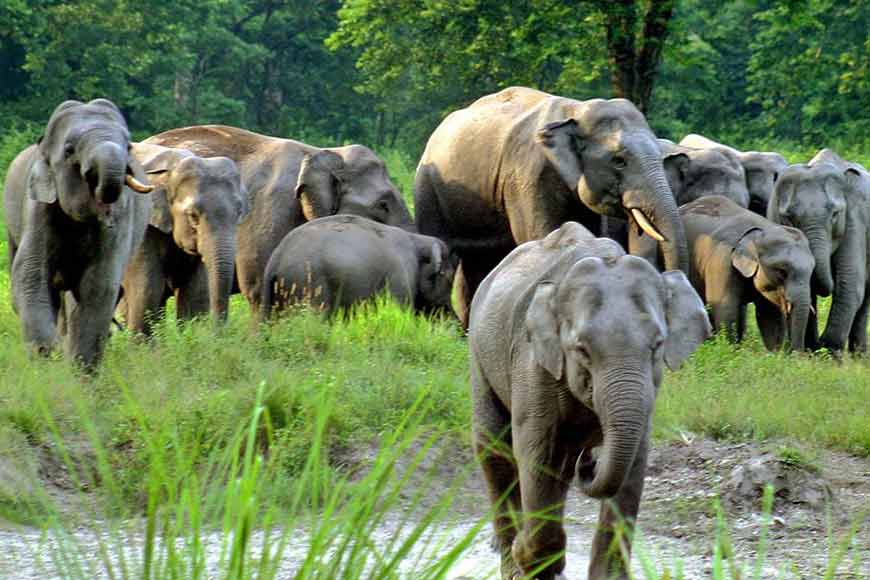Human-Pachyderm conflict is well tackled in Bengal leading to increase in elephant herds

On World Elephant Day, what disturbs any naturalist of India is the Human-Pachyderm conflict. Something that over past many decades have killed thousands of elephants that are endangered today. Like their African cousins, Asian elephants have dwindled in numbers over the years. Either baby elephants falling into pits and dying while being chased by humans, or those killed while crossing railway tracks. Unlike Africa, India does not have the problem of Elephant poaching for their tusks, at least in North Bengal such poaching cases are almost nil.
The human pachyderm conflict has a history. It started both in South and North Bengal, due to rampant clearing of Jharkhand and Mayurbhanj forests, where mining and other activities in the last few decades have led to huge forest depletion. Historical records of south Bengal show that prior to 1900, the area had dense Sal forests and was home to elephant herds. But rapid deforestation in the early 20th century changed the forest landscape. Elephants almost vanished from this region for several decades—till the 1980s, as per records. Instead elephant herds from Dalma Wildlife Sanctuary in Jharkhand started migrating to south of West Bengal from 1987 onwards. Before that, there is only a single record of elephant sighting—in 1976—when a herd of 42 elephants migrated from the Dalma to Sindri in Purulia district.
The State Forest Department has taken up several innovative methods to keep the elephants away and even creating awareness among villagers, taking them into their fold, so that instead of poisoning elephants that usually people in Kerala do (in Kerala incidentally almost every week an elephant is killed), the people of Bengal try to protect these giant creatures along with protecting their own ripe crops that the elephants invade every cropping season.
Regular awareness campaigns are held with villagers with strict do’s and don’ts that they have to follow. The electric wire sensing used are of high-voltage but low ampere and their batteries are charged by solar panels. Since last three years, West Bengal Forest Department has started sending bulk sms es to villagers and gram pradhans, for advance warning, in case sighting of elephants in the area happens. More and more areas are being brought within its ambit for wider spread of the Sms es. Several water holes, fodder grass, fruit trees have also been planted so that elephants get their food from the forest itself.
Interestingly, return of elephant herds to West Midnapore, Bankura and Purulia after decades is also an indicator of robust forest growth in South Bengal, the result of an afforestation drive carried out by the forest department and local communities in a joint forest management (JFM) programme. Incidentally, the elephants’ migration was aided by the success of forestry projects in West Bengal, under which large patches of degraded forest were turned into regenerated forest. These forest patches provide corridors for movement and convenient shelter to elephants. A change detection study based on satellite data from 1988 to 1991 for Midnapore, Bankura and Purulia districts confirmed an increase of 315 square km in forest cover.
Emergence of elephant herds in South Bengal is really a new issue but Bengal is tackling it very efficiently. Initially, the herd from the Dalma Sanctuary would come up to Jhargram in West Midnapore, their movement restricted up to the western bank of river Kangsabati. Later, the herds started crossing the Kangsabati and spending most of the time in the eastern part of the river as this area was fertile with food and water in abundance. With each passing year, as the migratory herds kept expanding their numbers, they began pushing deeper into south Bengal, even crossing over to Burdwan district!
The forest department estimates that at present there are about 140-150 elephants in South Bengal. Of this, about one-third return to their home in the Dalma hills in Jharkhand but the majority stay back as there is easy availability of food and water. South Bengal is not a natural habitat for elephants and the exponential pachyderm population has made matters worse for villagers and forest officials. Still they handle these huge animals with a lot of caution. According to some officials, chasing away elephants by scare tactics causes damage to the herd, as it splits into smaller groups and run amok in various directions. In the process, they raid multiple fields of crops. But the best modern technique is forming of an Elephant Movement Coordination Committee (EMCC) to tackle this menace. The EMCC brings together officials of different districts through WhatsApp groups and email exchanges, updating a herd’s movement. A special human-wildlife conflict mitigation cell has been established which sends out bulk SMS alerts to villagers warning them about a particular herd. This is an early warning system to prevent human casualty.









